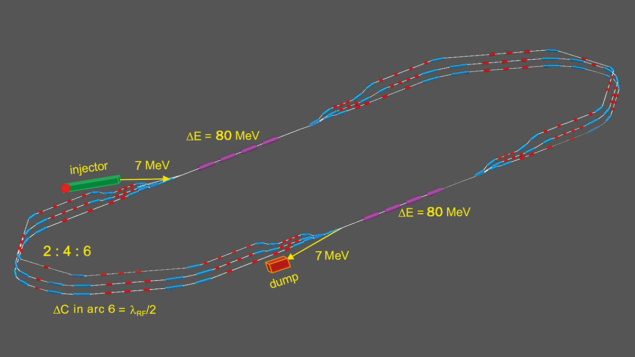
Following the publication of an updated conceptual design report in 2021, CERN continues to support studies for the proposed electron–hadron colliders LHeC and FCC-eh as potential options for the future, and to provide input to the next update of the European strategy for particle physics, with emphasis on FCC. LHeC would require the LHC to be modified, while FCC-eh is a possible operational mode of the proposed Future Circular Collider at CERN. A key factor in studies for a possible future “ep/eA” collider is power consumption, for which researchers around the world are exploring the use of energy recovery linacs at the high-energy frontier.
The ep/eA programme finds itself at a crossroad between nuclear and particle physics, with synergies with astroparticle physics. It has the potential to empower the High-Luminosity LHC (HL-LHC) physics programme in a unique way, and allows for a deeper exploration of the electroweak and strong sectors of the Standard Model beyond what can be achieved with proton–proton collisions alone. In many cases, adding LHeC to HL-LHC data can significantly improve the precision of Higgs-boson measurements – similar to the improvements expected when moving from the LHC to HL-LHC.
The innovative spirit of the ep/eA community was demonstrated during the workshop “Electrons for the LHC – LHeC/FCCeh and PERLE” held at IJCLab from 26 to 28 October. As the ep/eA community moves from the former HERA facility and from the Electron-Ion Collider, currently under construction at Brookhaven, to higher energies at LHeC and FCC-eh, the threshold will be reached to study electroweak, top and Higgs physics in deep-inelastic scattering (DIS) processes for the first time. In addition, these programmes enable the exploration of the low Bjorken-x frontier orders of magnitude beyond current DIS results. At this stage, it is unclear what physics will be unlocked if hadronic matter is broken into even smaller pieces. In recent years, particle physicists have learned that the ultimate precision for Higgs-boson physics lies in the complementarity of e+e–, pp and ep collisions, as embedded in the FCC programme, for example. Exploiting this complementarity is key to exploring new territories via the Higgs and dark sectors, as well as zooming in on potential anomalies in our data.
The October workshop underlined the advantage of a joint ep/pp/eA/AA/pA interaction experiment, and the need to further document its added scientific value. For example, a precision of 1 MeV on the W-boson mass could be within reach. In short, the ep data allows constraints to be placed on the most important systematic uncertainty when measuring the W-boson mass with pp data.
Reduced power
Participants also addressed how to reduce the power consumption of LHeC and FCC-eh. PERLE, an expanding international collaboration revolving around a multi-turn demonstrator facility being pursued at IJCLab in Orsay for energy recovery linacs (ERLs) at high beam currents, is ready to become Europe’s leading centre for developing and testing sustainable accelerating systems.
At this stage, it is unclear what physics will be unlocked if hadronic matter is broken into even smaller pieces
As demonstrated at the workshop, with additional R&D on ERLs and ep colliders we might be able to further reduce the power consumption of the LHeC (and FCC-eh) to as low as 50 MW. These values are to be compared with the GW power consumption if there was no energy recovery and therefore provide a power-economic avenue to extend the Higgs precision frontier beyond the HL-LHC. ERLs are not uniquely applicable to eA colliders, but have been discussed for future linear and circular e+e– colliders too. With PERLE and other sustainable accelerating systems, the ep/eA programme has the ambition to deliver a demonstration of ERL technology at high beam current, potentially towards options for an ERL-based Higgs factory.
Workshop participants are engaged to further develop an ep/eA programme with the ability to significantly enrich this overall strategy with a view to finding cracks in the Standard Model and/or finding new phenomena that further our understanding of nature at the smallest and largest scales.





